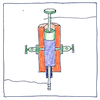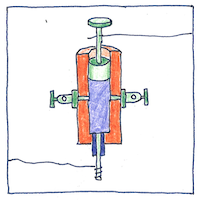Edouard Branly
electromagnetism

|
Coherer
They called them Hertzian waves because Heinrich Hertz had discovered them and Marconi had not yet invented the radio. Edouard Branly was experimenting to see the effects of electrical charges and sparks on metal filings, and began to make devices containing metal filings to detect the presence of electric waves. By 1894 people including Oliver Lodge were making their Branly coherers to detect Hertzian waves.
History of metal filings
Even the ancients knew magnets attracted metal filings. Even before batteries were invented, in 1850, Peter Samuel Munk noted that static electricity affected the resistance of metal filings. Even before Edouard Branly’s work, Temistocle Calzecchi-Onesti discovered that metal filings between brass plates, became conductive when a voltage was applied to the plates.
Cohering
Elements cohere, as did the chemicals of life, to defy the law of entropy. A line composed of points, too fine, then too many to count, to branch into millions. Particules in a brain, we don’t know how, arrange to form memories and guesses.



In radios, the coherer was replaced by the electrolytic detector, the crystal diode, and vacuum tubes such as the Fleming valve.
The French term particules denotes a small element of a body.
See also in The book of science:
Readings in wikipedia: